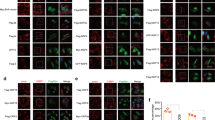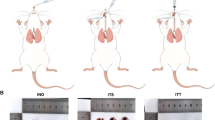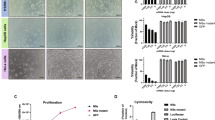Abstract
The balance between the innate immunity of the host and the ability of a pathogen to evade it strongly influences pathogenesis and virulence. The two nonstructural (NS) proteins, NS1 and NS2, of respiratory syncytial virus (RSV) are critically required for RSV virulence. Together, they strongly suppress the type I interferon (IFN)-mediated innate immunity of the host cells by degrading or inhibiting multiple cellular factors required for either IFN induction or response pathways, including RIG-I, IRF3, IRF7, TBK1 and STAT2. Here, we provide evidence for the existence of a large and heterogeneous degradative complex assembled by the NS proteins, which we named “NS-degradasome” (NSD). The NSD is roughly ∼300-750 kD in size, and its degradative activity was enhanced by the addition of purified mitochondria in vitro. Inside the cell, the majority of the NS proteins and the substrates of the NSD translocated to the mitochondria upon RSV infection. Genetic and pharmacological evidence shows that optimal suppression of innate immunity requires mitochondrial MAVS and mitochondrial motility. Together, we propose a novel paradigm in which the mitochondria, known to be important for the innate immune activation of the host, are also important for viral suppression of the innate immunity.
Similar content being viewed by others
Log in or create a free account to read this content
Gain free access to this article, as well as selected content from this journal and more on nature.com
or
References
Kawai T, Takahashi K, Sato S, et al. IPS-1, an adaptor triggering RIG-I- and Mda5-mediated type I interferon induction. Nat Immunol 2005; 6:981–988.
Meylan E, Curran J, Hofmann K, et al. Cardif is an adaptor protein in the RIG-I antiviral pathway and is targeted by hepatitis C virus. Nature 2005; 437:1167–1172.
Seth RB, Sun L, Ea CK, Chen ZJ . Identification and characterization of MAVS, a mitochondrial antiviral signaling protein that activates NF-kappaB and IRF3. Cell 2005; 122:669–682.
Xu LG, Wang YY, Han KJ, et al. VISA is an adapter protein required for virus-triggered IFN-beta signaling. Mol Cell 2005; 19:727–740.
Belgnaoui SM, Paz S, Hiscott J . Orchestrating the interferon antiviral response through the mitochondrial antiviral signaling (MAVS) adapter. Curr Opin Immunol 2011; 23:564–572.
Fensterl V, Sen GC . Interferons and viral infections. Biofactors 2009; 35:14–20.
Aaronson DS, Horvath CM . A road map for those who don't know JAK-STAT. Science 2002; 296:1653–1655.
Sen GC, Sarkar SN . The interferon-stimulated genes: targets of direct signaling by interferons, double-stranded RNA, and viruses. Curr Top Microbiol Immunol 2007; 316:233–250.
Stark GR, Kerr IM, Williams BRG, Silverman RH, Schreiber RD . How cells respond to interferons. Annu Rev Biochem 1998; 67:227–264.
Komuro A, Bamming D, Horvath CM . Negative regulation of cytoplasmic RNA-mediated antiviral signaling. Cytokine 2008; 43:350–358.
Kumar H, Kawai T, Akira S . Pathogen recognition by the innate immune system. Int Rev Immunol 2011; 30:16–34.
Yoneyama M, Fujita T . Recognition of viral nucleic acids in innate immunity. Rev Med Virol 2010; 20:4–22.
Haller O, Kochs G, Weber F . The interferon response circuit: induction and suppression by pathogenic viruses. Virology 2006; 344:119–130.
Randall RE, Goodbourn S . Interferons and viruses: an interplay between induction, signalling, antiviral responses and virus countermeasures. J Gen Virol 2008; 89:1–47.
Unterholzner L, Bowie AG . The interplay between viruses and innate immune signaling: recent insights and therapeutic opportunities. Biochem Pharmacol 2008; 75:589–602.
Bossert B, Marozin S, Conzelmann KK . Nonstructural proteins NS1 and NS2 of bovine respiratory syncytial virus block activation of interferon regulatory factor 3. J Virol 2003; 77:8661–8668.
Boyapalle S, Wong T, Garay J, et al. Respiratory syncytial virus NS1 protein colocalizes with mitochondrial antiviral signaling protein MAVS following infection. PLoS One 2012; 7:e29386.
Elliott J, Lynch OT, Suessmuth Y, et al. Respiratory syncytial virus NS1 protein degrades STAT2 by using the Elongin-Cullin E3 ligase. J Virol 2007; 81:3428–3436.
Jin H, Zhou H, Cheng X, et al. Recombinant respiratory syncytial viruses with deletions in the NS1, NS2, SH, and M2–2 genes are attenuated in vitro and in vivo. Virology 2000; 273:210–218.
Ling Z, Tran KC, Teng MN . Human respiratory syncytial virus nonstructural protein NS2 antagonizes the activation of beta interferon transcription by interacting with RIG-I. J Virol 2009; 83:3734–3742.
Lo MS, Brazas RM, Holtzman MJ . Respiratory syncytial virus nonstructural proteins NS1 and NS2 mediate inhibition of Stat2 expression and alpha/beta interferon responsiveness. J Virol 2005; 79:9315–9319.
Ramaswamy M, Shi L, Varga SM, Barik S, Behlke MA, Look DC . Respiratory syncytial virus nonstructural protein 2 specifically inhibits type I interferon signal transduction. Virology 2006; 344:328–339.
Ren J, Liu T, Pang L, et al. A novel mechanism for the inhibition of interferon regulatory factor-3-dependent gene expression by human respiratory syncytial virus NS1 protein. J Gen Virol 2011; 92:2153–2159.
Schlender J, Bossert B, Buchholz U, Conzelmann KK . Bovine respiratory syncytial virus nonstructural proteins NS1 and NS2 cooperatively antagonize alpha/beta interferon-induced antiviral response. J Virol 74:8234–8242.
Spann KM, Tran KC, Chi B, Rabin RL, Collins PL . Suppression of the induction of alpha, beta, and lambda interferons by the NS1 and NS2 proteins of human respiratory syncytial virus in human epithelial cells and macrophages [corrected]. J Virol 2004; 78:4363–4369.
Spann KM, Tran KC, Collins PL . Effects of nonstructural proteins NS1 and NS2 of human respiratory syncytial virus on interferon regulatory factor 3, NF-kappaB, and proinflammatory cytokines. J Virol 2005; 79:5353–5362.
Swedan S, Andrews J, Majumdar T, Musiyenko A, Barik S . Multiple functional domains and complexes of the two nonstructural proteins of human respiratory syncytial virus contribute to interferon suppression and cellular location. J Virol 2011; 85:10090–10100.
Swedan S, Musiyenko A, Barik S . Respiratory syncytial virus nonstructural proteins decrease levels of multiple members of the cellular interferon pathways. J Virol 2009; 83:9682–9693.
Teng MN, Collins PL . Altered growth characteristics of recombinant respiratory syncytial viruses which do not produce NS2 protein. J Virol 1999; 73:466–473.
Jin H, Zhou H, Cheng X, Tang R, Munoz M, Nguyen N . Evaluation of recombinant respiratory syncytial virus gene deletion mutants in African green monkeys for their potential as live attenuated vaccine candidates. Vaccine 2003; 21:3647–3652.
Teng MN, Whitehead SS, Bermingham A, et al. Recombinant respiratory syncytial virus that does not express the NS1 or M2–2 protein is highly attenuated and immunogenic in chimpanzees. J Virol 2000; 74:9317–9321.
Valarcher JF, Furze J, Wyld S, Cook R, Conzelmann KK, et al. Role of alpha/beta interferons in the attenuation and immunogenicity of recombinant bovine respiratory syncytial viruses lacking NS proteins. J Virol 2003; 77:8426–8439.
Lebiedzinska M, Szabadkai G, Jones AW, Duszynski J, Wieckowski MR . Interactions between the endoplasmic reticulum, mitochondria, plasma membrane and other subcellular organelles. Int J Biochem Cell Biol 2009; 41:1805–1816.
Hayashi T, Rizzuto R, Hajnoczky G, Su TP . MAM: more than just a housekeeper. Trends Cell Biol 2009; 19:81–88.
Horner SM, Liu HM, Park HS, Briley J, Gale M, Jr . Mitochondrial-associated endoplasmic reticulum membranes (MAM) form innate immune synapses and are targeted by hepatitis C virus. Proc Natl Acad Sci USA 2011; 108:14590–14595.
Bozidis P, Williamson CD, Colberg-Poley AM . Isolation of endoplasmic reticulum, mitochondria, and mitochondria-associated membrane fractions from transfected cells and from human cytomegalovirus-infected primary fibroblasts. Curr Protoc Cell Biol 2007; Chap 3:unit 3.27.
Chattopadhyay S, Marques JT, Yamashita M, et al. Viral apoptosis is induced by IRF-3-mediated activation of Bax. EMBO J 2010; 29:1762–1773.
Burke E, Mahoney NM, Almo SC, Barik S . Profilin is required for optimal actin-dependent transcription of respiratory syncytial virus genome RNA. J Virol 2000; 74:669–675.
Atreya PL, Kulkarni S . Respiratory syncytial virus strain A2 is resistant to the antiviral effects of type I interferons and human MxA. Virology 1999; 261:227–241.
Gale M Jr, Foy EM . Evasion of intracellular host defence by hepatitis C virus. Nature 2005; 436:939–945.
Loo YM, Owen DM, Li K, et al. Viral and therapeutic control of IFN-beta promoter stimulator 1 during hepatitis C virus infection. Proc Natl Acad Sci USA 2006; 103:6001–6006.
Fensterl V, Sen GC . The ISG56/IFIT1 gene family. J Interferon Cytokine Res 2011; 31:71–78.
Bereiter-Hahn J, Voth M . Dynamics of mitochondria in living cells: shape changes, dislocations, fusion, and fission of mitochondria. Microsc Res Tech 1994; 27:198–219.
Otera H, Mihara K . Molecular mechanisms and physiologic functions of mitochondrial dynamics. J Biochem 2011; 149:241–251.
Ball EH, Singer SJ . Mitochondria are associated with microtubules and not with intermediate filaments in cultured fibroblasts. Proc Natl Acad Sci USA 1982; 79:123–126.
Müller M, Mironov SL, Ivannikov MV, Schmidt J, Richter DW (2005) Mitochondrial organization and motility probed by two-photon microscopy in cultured mouse brainstem neurons. Exp Cell Res 303:114–127.
Munday DC, Emmott E, Surtees R, et al. Quantitative proteomic analysis of A549 cells infected with human respiratory syncytial virus. Mol Cell Proteomics 2010; 9:2438–2459.
Bai Y, Hájek P, Chomyn A, et al. Lack of complex I activity in human cells carrying a mutation in MtDNA-encoded ND4 subunit is corrected by the Saccharomyces cerevisiae NADH-quinone oxidoreductase (NDI1) gene. J Biol Chem 2001; 276:38808–38813.
Kennady PK, Ormerod MG, Singh S, Pande G . Variation of mitochondrial size during the cell cycle: A multiparameter flow cytometric and microscopic study. Cytometry A 2004; 62:97–108.
Chen H, Detmer SA, Ewald AJ, Griffin EE, Fraser SE, Chan DC . Mitofusins Mfn1 and Mfn2 coordinately regulate mitochondrial fusion and are essential for embryonic development. J Cell Biol 2003; 160:189–200.
Legros F, Lombès A, Frachon P, Rojo M . Mitochondrial fusion in human cells is efficient, requires the inner membrane potential, and is mediated by mitofusins. Mol Biol Cell 2002; 13:4343–4254.
Santel A, Frank S, Gaume B, Herrler M, Youle RJ, Fuller MT . Mitofusin-1 protein is a generally expressed mediator of mitochondrial fusion in mammalian cells. J Cell Sci 2003; 116:2763–2774.
Santel A, Fuller MT . Control of mitochondrial morphology by a human mitofusin. J Cell Sci 2001; 114:867–874.
Eura Y, Ishihara N, Yokota S, Mihara K . Two mitofusin proteins, mammalian homologues of FZO, with distinct functions are both required for mitochondrial fusion. J Biochem 2003; 134:333–344.
Castanier C, Garcin D, Vazquez A, Arnoult D . Mitochondrial dynamics regulate the RIG-I-like receptor antiviral pathway. EMBO Rep 2010; 11:133–138.
Ciechanover A, Iwai K . The ubiquitin system: from basic mechanisms to the patient bed. IUBMB Life 2004; 56:193–201.
Ye J, Maniatis T . Negative regulation of interferon-β gene expression during acute and persistent virus infections. PLoS One 2011; 6:e20681.
Potter JA, Randall RE, Taylor GL . Crystal structure of human IPS-1/MAVS/VISA/Cardif caspase activation recruitment domain. BMC Struct Biol 2008; 8:11.
Rothenfusser S, Goutagny N, DiPerna G, et al. The RNA helicase Lgp2 inhibits TLR-independent sensing of viral replication by retinoic acid-inducible gene-I. J Immunol 2005; 175:5260–5268.
Onoguchi K, Onomoto K, Takamatsu S, et al. Virus-infection or 5′ppp-RNA activates antiviral signal through redistribution of IPS-1 mediated by MFN1. PLoS Pathog 2010; 6:e1001012.
de Brito OM, Scorrano L . Mitofusin 2 tethers endoplasmic reticulum to mitochondria. Nature 2008; 456:605–610.
Sano R, Annunziata I, Patterson A, et al. GM1-ganglioside accumulation at the mitochondria-associated ER membranes links ER stress to Ca2+-dependent mitochondrial apoptosis. Mol Cell 2009; 36:500–511.
Wu F, Buckley S, Bui KC, et al. Cell cycle arrest in G0/G1 phase by contact inhibition and TGF-beta 1 in mink Mv1Lu lung epithelial cells. Am J Physiol 1996; 270:L879–L888.
Gibbs JD, Ornoff DM, Igo HA, Zeng JY, Imani F . Cell cycle arrest by transforming growth factor beta1 enhances replication of respiratory syncytial virus in lung epithelial cells. J Virol 2009; 83:12424–12431.
Wu W, Munday DC, Howell G, Platt G, Barr JN, Hiscox JA . Characterization of the interaction between human respiratory syncytial virus and the cell cycle in continuous cell culture and primary human airway epithelial cells. J Virol 2011; 85:10300–10309.
Bian T, Gibbs JD, Örvell C, Imani F . Respiratory syncytial virus matrix protein induces lung epithelial cell cycle arrest through a p53 dependent pathway. PLoS One 2012; 7:e38052.
Ghildyal R, Baulch-Brown C, Mills J, Meanger J . The matrix protein of Human respiratory syncytial virus localises to the nucleus of infected cells and inhibits transcription. Arch Virol 2003; 148:1419–1429.
Ghildyal R, Ho A, Jans DA . Central role of the respiratory syncytial virus matrix protein in infection. FEMS Microbiol Rev 2006; 30:692–705.
Wu W, Tran KC, Teng MN, et al. The interactome of the human respiratory syncytial virus NS1 protein highlights multiple effects on host cell biology. J Virol 2012; 86:7777–7789.
Johnson CL, Owen DM, Gale M, Jr . Functional and therapeutic analysis of hepatitis C virus NS3.4A protease control of antiviral immune defense. J Biol Chem 2007; 282:10792–10803.
Yoneyama, M, Kikuchi, M, Natsukawa, T, Shinobu N, Imaizumi T . The RNA helicase RIG-I has an essential function in double-stranded RNA-induced innate antiviral responses. Nat Immunol 2004; 5:730–737.
Schneider CA, Rasband WS, Eliceiri KW . NIH Image to ImageJ: 25 years of image analysis. Nat Methods 2012; 9:671–675.
Acknowledgements
This research was supported in part by an Ohio Third Frontier Grant, cost-share funds from the Provost and the Research office of the Cleveland State University (CSU), NIH 1 S10 OD010381 (all to SB) and NIH grants (AI073303 and CA068782 to GCS). We are indebted to Chris Basler, Adolfo García-Sastre (Mount Sinai School of Medicine, NY, USA), Carl Ware (Sanford Burnham Medical Research Institute, La Jolla, USA) and Michael Gale (University of Washington, Seattle, USA) for various recombinant plasmids of the IFN pathway genes, and to Michael Gale for the NS3/4A-expressing cell line.
Author information
Authors and Affiliations
Corresponding author
Rights and permissions
About this article
Cite this article
Goswami, R., Majumdar, T., Dhar, J. et al. Viral degradasome hijacks mitochondria to suppress innate immunity. Cell Res 23, 1025–1042 (2013). https://doi.org/10.1038/cr.2013.98
Received:
Revised:
Accepted:
Published:
Issue date:
DOI: https://doi.org/10.1038/cr.2013.98
Keywords
This article is cited by
-
Early innate immune response triggered by the human respiratory syncytial virus and its regulation by ubiquitination/deubiquitination processes
Journal of Biomedical Science (2022)
-
Microbiome-Transcriptome Interactions Related to Severity of Respiratory Syncytial Virus Infection
Scientific Reports (2019)
-
The nonstructural proteins of Pneumoviruses are remarkably distinct in substrate diversity and specificity
Virology Journal (2017)
-
The RNA binding protein La/SS-B promotes RIG-I-mediated type I and type III IFN responses following Sendai viral infection
Scientific Reports (2017)
-
Structural basis for human respiratory syncytial virus NS1-mediated modulation of host responses
Nature Microbiology (2017)



